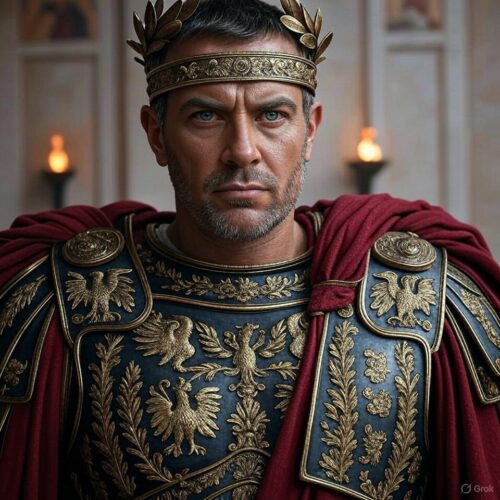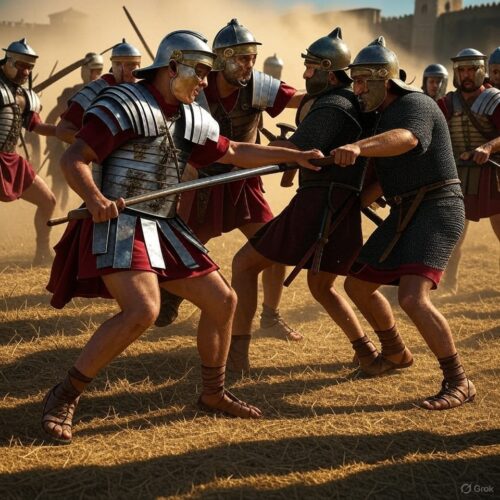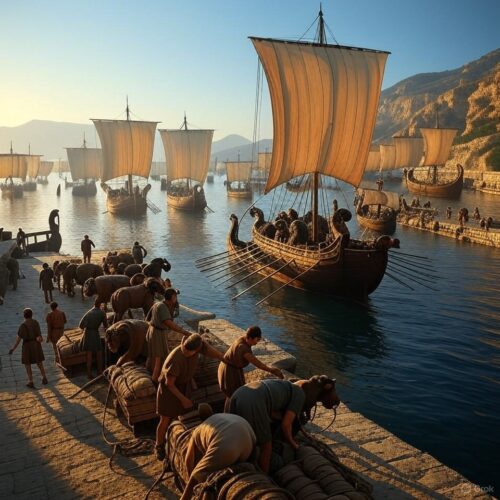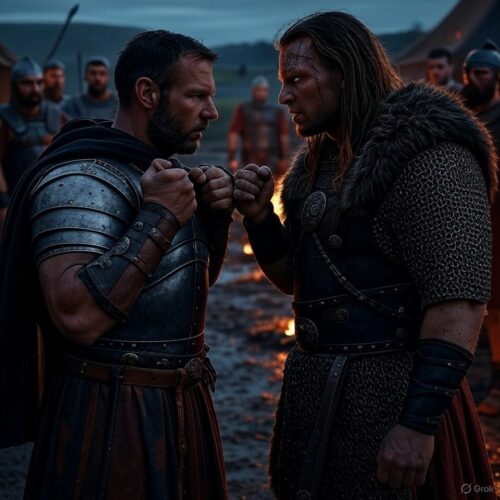Imagine a world where the once-mighty Roman Empire, a colossus that spanned continents and defined civilization for centuries, teeters on the brink of oblivion. Barbarian hordes carve up its territories, emperors rise and fall like autumn leaves, and the very fabric of society unravels amid corruption, invasion, and economic ruin. Into this chaos steps a man of vision and vigor, determined to stem the tide and restore glory to a dying realm. This is the story of Julius Maiorianus, better known as Majorian, the last Western Roman Emperor who truly fought to save his empire. On August 7, 461, his ambitious reign came to a brutal end with his beheading near the river Iria in northwest Italy, a victim of betrayal and political intrigue. But his efforts, though ultimately thwarted, offer a riveting tale of leadership, reform, and resilience that echoes through the ages.
Distant history often feels like a dusty scroll, but Majorian’s saga is anything but dull. It’s a high-stakes drama filled with battlefield heroics, cunning alliances, and bold legislative strokes—all set against the backdrop of the Western Roman Empire’s final gasps. As we dive into the depths of this event, we’ll uncover the intricate web of events that led to that fateful day in 461, exploring the empire’s decline, Majorian’s rise, his whirlwind reforms, and the shadowy forces that sealed his fate. Buckle up for a journey through late antiquity that’s packed with intrigue, strategy, and a dash of Roman flair—think gladiatorial grit meets senatorial scheming.
### The Crumbling Foundations: The Western Roman Empire in the 5th Century
To understand Majorian’s significance, we must first set the stage with the turbulent world he inherited. By the early 5th century, the Western Roman Empire was a shadow of its former self. The sack of Rome by the Visigoths in 410 under Alaric sent shockwaves across the Mediterranean, symbolizing the vulnerability of what had once been invincible. Invasions by various barbarian groups—Vandals, Suebi, Burgundians, Franks, and others—eroded imperial control over provinces like Gaul, Hispania, and Africa. The loss of North Africa to the Vandals in 439 was particularly devastating, as it deprived Rome of vital grain supplies and tax revenues, exacerbating famine and economic collapse in Italy.
Politically, the empire was plagued by weak emperors and powerful generals. The Theodosian dynasty ended with Valentinian III’s assassination in 455, triggering a rapid succession of puppet rulers manipulated by barbarian warlords. Ricimer, a Suebian-Visigothic general who rose to become magister militum (master of soldiers), epitomized this era’s power brokers. Born around 405, Ricimer was no mere barbarian; he was Romanized, having served in the imperial army, and wielded immense influence over the throne. His role was akin to a kingmaker, installing and deposing emperors at will to maintain his dominance.
The Eastern Roman Empire, based in Constantinople, fared better under emperors like Marcian (450–457) and Leo I (457–474), but relations with the West were strained. The East provided occasional aid but viewed the West as a junior partner, often withholding full recognition from its emperors. This division, formalized since 395, accelerated the West’s isolation. Amid this, corruption ran rampant: Senators hoarded wealth, tax evasion was widespread, and public buildings crumbled as officials pilfered materials for private villas. Population decline from wars, plagues, and migrations further weakened the military, forcing reliance on foederati—barbarian federates who fought for Rome but often pursued their own agendas.
It was into this maelstrom that Majorian emerged, a rare figure who combined military prowess with administrative acumen. His story isn’t just about one man’s downfall; it’s a microcosm of the empire’s terminal illness, where even the most determined efforts couldn’t reverse centuries of decay.
### Majorian’s Early Life: From Battlefield Prodigy to Exiled Ally
Julius Valerius Majorianus was born around November 420 in Roman Gaul, into a family steeped in military tradition. His grandfather, Majorianus, had served as magister militum under Emperor Theodosius I (379–395), commanding forces during campaigns against the Goths and participating in the pivotal Battle of the Frigidus in 394. This lineage instilled in young Majorian a sense of duty and ambition. He entered military service under Flavius Aetius, the dominant general of the mid-5th century, often called “the last of the Romans” for his defenses against Attila the Hun.
Majorian quickly distinguished himself. In 447 or 448, he fought in the defense of Tours against the Franks led by King Clodio, showcasing tactical brilliance. Later that year, at the Battle near Vicus Helena (modern Arlaines in France), Majorian and Aetius routed the Franks, with Majorian personally engaging in combat alongside future emperor Avitus. These victories highlighted his skill as a commander, earning him promotion to comes domesticorum, commander of the imperial guard.
However, court politics intervened. In 450, Emperor Valentinian III considered betrothing his daughter Placidia to Majorian to secure loyalty, but Aetius, fearing a rival for his son Gaudentius’s prospects, engineered Majorian’s removal from the staff. Majorian retreated to private life on his estates, a common fate for those out of favor in the intrigue-ridden imperial court.
The tides turned with Aetius’s murder by Valentinian in 454, followed by the emperor’s own assassination in 455 by Aetius’s loyalists. The ensuing chaos saw Petronius Maximus briefly seize the throne, only to perish during the Vandal sack of Rome. Avitus, backed by the Visigoths under Theodoric II, became emperor, appointing Majorian as comes domesticorum and Ricimer as comes rei militaris. Together, they formed a formidable duo, but tensions simmered.
By 456, Avitus lost support among Italian aristocrats due to his Gallic origins and reliance on Visigoths. Majorian and Ricimer revolted, killing Avitus’s magister militum Remistus at Ravenna. Ricimer then defeated Avitus at the Battle of Placentia on October 17, 456, capturing and deposing him. Avitus was made bishop of Placentia but likely starved to death soon after. With the throne vacant, Ricimer, as a barbarian ineligible for the purple, positioned Majorian as his puppet— or so he thought.
### Ascension to the Throne: A Reluctant Emperor’s Bold Start
Majorian was acclaimed emperor by the army on April 1, 457, near Ravenna at Columella, though some sources suggest December 28, 457, as the formal date. He assumed the consulate for 458, minting coins proclaiming “Victoria Augg” (Victory of the Augusti). However, the Eastern Emperor Leo I did not recognize him initially, listing only himself as consul in Eastern records. This snub underscored the West’s diminished status, but Majorian pressed on, focusing on immediate threats.
His first challenge came in 457 when Vandals under Gaiseric raided Campania. Majorian personally led forces to the Battle of Garigliano, slaughtering many invaders and repelling the assault. To bolster defenses, he issued Novella Maioriani 1 (De reddito iure armorum), allowing citizens to bear arms, and Novella Maioriani 3 (De aurigis et seditiosis), curbing urban unrest. He recruited barbarian mercenaries—Gepids, Ostrogoths, Rugii, Sciri, and Huns—to augment the depleted Roman legions, while rebuilding fleets at Miseno and Ravenna for future offensives.
Majorian’s diplomacy was equally shrewd. He married his daughter to Ricimer to cement their alliance and sought Gallo-Roman support by appointing Avitus’s son-in-law, Sidonius Apollinaris, as comes urbis Romae. Sidonius’s panegyric praised Majorian as a restorer of Rome, comparing him to legendary heroes.
### Military Campaigns: Reconquests in Gaul and Hispania
Majorian’s most audacious achievements were his reconquests. In late 458, he crossed the Alps into Gaul with an army including Hun and Scirian auxiliaries. The Visigoths under Theodoric II had expanded into southern Gaul and Hispania, defying federate status. Majorian confronted them at the Battle of Arelate (modern Arles), decisively defeating the Goths and capturing the city. Theodoric was forced to renew the federate treaty of 418, relinquishing conquests in Hispania and returning to Toulouse as a Roman ally.
Majorian then turned to the Burgundians, who had seized Lugdunum (Lyon). He reconquered the city, imposing a treaty that confined them to their territories. To secure loyalty, he appointed Aegidius, a trusted general, as magister militum per Gallias, and remitted taxes to Gallic provinces via Novella Maioriani 2 (De indulgentiis reliquorum), forgiving arrears up to 457 to alleviate burdens from invasions.
In Hispania, Majorian dispatched generals Nepotianus and Sunieric against the Suebi, who had sacked Roman cities. They reconquered Scalabis (Santarem) and defeated the Suebi at Lucus Augusti (Lugo) in 460. These victories restored Roman control over parts of Hispania Tarraconensis, though the northwest remained contested.
The pinnacle of Majorian’s military ambition was the planned invasion of Vandal Africa. In 460, he assembled a fleet of 300 ships at Portus Illicitanus near Cartagena, intending to cross to Mauretania and reclaim the grain-rich province. Tragically, Vandal spies or traitors sabotaged the fleet, burning many ships at anchor. Forced to negotiate, Majorian signed a peace treaty recognizing Vandal holdings in Mauretania, a bitter setback that undermined his prestige.
### Reforms and Governance: A Vision for Renewal
Undeterred by military reversals, Majorian pursued sweeping reforms through his Novellae Maioriani, twelve laws issued between 458 and 460. These addressed the empire’s systemic ills with remarkable foresight.
Fiscal reforms were central. Novella Maioriani 2 remitted tax arrears, while Novella Maioriani 7 (De bonis caducis sive proscriptorum) reorganized tax collection, preventing evasion by the powerful. He targeted senatorial corruption, punishing officials who demolished public buildings for private use in Novella Maioriani 4 (De aedificiis pubblicis), preserving Rome’s architectural heritage like the Colosseum and aqueducts.
Administrative changes included Novella Maioriani 11 (De defensoribus civitatum), reviving the defensor civitatis to protect citizens from abuses, elected by local clergy and landowners. To combat population decline, Novella Maioriani 6 set the minimum age for nuns at 40, encouraging marriage and childbirth among young women. Novella Maioriani 9 reformed curiales (city councilors), easing their burdens to prevent flight from duties.
Majorian’s coinage reflected his vigor. He issued solidi (gold coins) depicting himself in armor, symbolizing military strength, and reformed bronze nummi to stabilize the economy. He balanced relations with the Senate, appointing consuls like Ricimer (459) and Eastern figures, and courted the Gallic aristocracy through tax relief and appointments.
Yet these reforms sowed seeds of discontent. By cracking down on corruption, Majorian alienated the Senate, whose members profited from the status quo. His reliance on barbarian troops and Gallic support further estranged Italian elites, who viewed him as too “provincial.”
### The Path to Betrayal: Tensions with Ricimer
Ricimer, initially Majorian’s ally, grew resentful. As patricius since 457, Ricimer expected to control the emperor, but Majorian’s independence chafed. The failed African expedition provided an opportunity. In late 460, Majorian disbanded his expensive mercenary army at Arelate to cut costs, leaving him vulnerable.
While wintering in Arelate, Majorian planned reforms, but Ricimer rallied opposition in Italy. Sources suggest Ricimer envied Majorian’s successes and feared his growing power. By summer 461, Majorian headed to Rome with a small guard, aiming for Ravenna. Ricimer intercepted him near Dertona (Tortona).
### The Fateful Day: Deposition and Execution on August 7, 461
On August 2, 461, Ricimer confronted Majorian at Dertona, arresting him with barbarian troops. Majorian was stripped of his imperial regalia—the purple robe and diadem—and deposed. Tortured and beaten for five days, he was beheaded on August 7 near the river Iria (now Staffora), his body discarded unceremoniously. Sources vary slightly: the Gallic Chronicle of 511 places the killing at Tortona, Hydatius attributes it to envy, Marcellinus Comes mentions the Ilyra river, and the Fasti Vindobonenses confirm the dates—deposition on August 3, death on August 7. John of Antioch describes the brutal stripping and beheading, while later Procopius claims dysentery, likely a cover-up to mask the assassination.
Majorian was about 40 years old, his reign lasting just four years. No grand funeral honored him; his death was a stark symbol of the empire’s barbarization.
### Aftermath and Legacy: Accelerating the Fall
Majorian’s death hastened the Western Empire’s collapse. Ricimer installed Libius Severus as puppet emperor, but without Majorian’s energy, territories slipped away. Gaul fragmented under Aegidius, who rebelled against Ricimer, establishing a semi-independent domain. Hispania fell further to the Suebi and Visigoths, and Vandals raided unchecked.
The empire limped on until 476, when Odoacer deposed Romulus Augustulus, traditionally marking the end. Majorian’s reconquests were short-lived; by 468, another African expedition under Leo I failed disastrously. Historians like Edward Gibbon praised Majorian as “a great and heroic character,” the last emperor to attempt genuine restoration. His laws influenced the Breviary of Alaric in 506, preserving Roman legal traditions into the Middle Ages.
Majorian’s story is a poignant reminder of what might have been. Had he succeeded against the Vandals or outmaneuvered Ricimer, the West might have stabilized. Instead, his execution on August 7, 461, closed a chapter on Roman revival, paving the way for medieval Europe.
### From Ancient Betrayal to Modern Empowerment: Applying Majorian’s Legacy Today
While Majorian’s tale is steeped in tragedy, its outcome— a visionary leader undone by internal division—holds profound lessons for today. In an era of personal challenges, from career setbacks to relationship strains, we can draw inspiration from his relentless drive to reform and restore. Majorian didn’t accept decline; he fought it with strategy and resolve. By applying his historical fact to your life, you can turn potential defeats into stepping stones for growth. Here’s how his legacy benefits you, with specific ways to harness it.
– **Embrace Bold Reforms for Personal Renewal**: Just as Majorian tackled corruption through laws like De aedificiis pubblicis, identify and eliminate self-sabotaging habits in your daily routine. For instance, if procrastination is your “senatorial corruption,” audit your time usage weekly and implement strict schedules to reclaim productivity, leading to career advancements or better health.
– **Build Strategic Alliances with Caution**: Majorian’s alliance with Ricimer turned fatal due to unchecked power dynamics. In your life, cultivate networks but vet them carefully—surround yourself with mentors who share your vision, like joining professional groups, while avoiding toxic influences that could undermine your goals, ensuring long-term support in pursuits like starting a business.
– **Pursue Reconquests in Your “Territories”**: Majorian’s campaigns in Gaul and Hispania reclaimed lost lands; similarly, reclaim neglected areas of your life, such as fitness or skills. Start by setting measurable targets, like exercising 30 minutes daily to “reconquer” health, resulting in increased energy and confidence for tackling bigger challenges.
– **Adapt to Setbacks with Resilience**: The sabotaged fleet was a crushing blow, yet Majorian negotiated peace. When facing failures—like a job loss—pivot quickly by updating your resume and networking aggressively, turning adversity into opportunity for a better role or entrepreneurial venture.
– **Foster Growth Through Policy-Like Habits**: Inspired by his natalist laws promoting population, invest in self-growth routines. Dedicate time to learning, such as reading one book monthly on personal development, to “populate” your mind with ideas that enhance creativity and problem-solving in everyday decisions.
To make this actionable, here’s a step-by-step plan to integrate Majorian’s lessons into your individual life over the next 30 days, transforming historical insight into personal triumph:
- **Week 1: Assess Your Empire**: Reflect on your current state. Journal about areas of “decline”—finances, relationships, health—and list three “reforms” per category, mirroring Majorian’s Novellae. Commit to one daily action, like tracking expenses to curb wasteful spending.
- **Week 2: Launch Reconquests**: Choose one neglected area and “campaign” against it. If it’s fitness, create a workout schedule with progressive goals, starting with walks and building to runs, tracking progress to build momentum like Majorian’s Gallic victories.
- **Week 3: Forge Alliances**: Identify and reach out to positive influences—a friend for accountability or a coach for guidance. Schedule weekly check-ins, while distancing from negative ones, to strengthen your support network without the risk of betrayal.
- **Week 4: Adapt and Celebrate**: Simulate a setback by reviewing past failures, then brainstorm pivots. End with a self-reward, like a special outing, to reinforce resilience. Review your journal to see growth, motivating continued effort.
By channeling Majorian’s spirit, you’ll not only honor a forgotten hero but ignite your own revival. History isn’t just the past—it’s fuel for your future. Rise like a Roman, and conquer your world!

